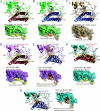Pathways of cross-species transmission of synthetically reconstructed zoonotic severe acute respiratory syndrome coronavirus
- PMID: 18579604
- PMCID: PMC2519660
- DOI: 10.1128/JVI.00818-08
Pathways of cross-species transmission of synthetically reconstructed zoonotic severe acute respiratory syndrome coronavirus
Abstract
Zoonotic severe acute respiratory syndrome coronavirus (SARS-CoV) likely evolved to infect humans by a series of transmission events between humans and animals in markets in China. Virus sequence data suggest that the palm civet served as an amplification host in which civet and human interaction fostered the evolution of the epidemic SARS Urbani strain. The prototypic civet strain of SARS-CoV, SZ16, was isolated from a palm civet but has not been successfully cultured in vitro. To propagate a chimeric recombinant SARS-CoV bearing an SZ16 spike (S) glycoprotein (icSZ16-S), we constructed cell lines expressing the civet ortholog (DBT-cACE2) of the SARS-CoV receptor (hACE2). Zoonotic SARS-CoV was completely dependent on ACE2 for entry. Urbani grew with similar kinetics in both the DBT-cACE2 and the DBT-hACE2 cells, while icSZ16-S only grew in DBT-cACE2 cells. The SZ16-S mutant viruses adapted to human airway epithelial cells and displayed enhanced affinity for hACE2 but exhibited severe growth defects in the DBT-cACE2 cells, suggesting that the evolutionary pathway that promoted efficient hACE2 interactions simultaneously abolished efficient cACE2 interactions. Structural modeling predicted two distinct biochemical interaction networks by which zoonotic receptor binding domain architecture can productively engage hACE2, but only the Urbani mutational repertoire promoted efficient usage of both hACE2 and cACE2 binding interfaces. Since dual species tropism was preserved in Urbani, it is likely that the virus evolved a high affinity for cACE2/hACE2 receptors through adaptation via repeated passages between human and civet hosts. Furthermore, zoonotic SARS-CoV was variably neutralized by antibodies that were effective against the epidemic strain, highlighting their utility for evaluating passive immunization efficacy.
Figures






Similar articles
-
Mechanisms of zoonotic severe acute respiratory syndrome coronavirus host range expansion in human airway epithelium.J Virol. 2008 Mar;82(5):2274-85. doi: 10.1128/JVI.02041-07. Epub 2007 Dec 19. J Virol. 2008. PMID: 18094188 Free PMC article.
-
Mechanisms of host receptor adaptation by severe acute respiratory syndrome coronavirus.J Biol Chem. 2012 Mar 16;287(12):8904-11. doi: 10.1074/jbc.M111.325803. Epub 2012 Jan 30. J Biol Chem. 2012. PMID: 22291007 Free PMC article.
-
Structural analysis of major species barriers between humans and palm civets for severe acute respiratory syndrome coronavirus infections.J Virol. 2008 Jul;82(14):6984-91. doi: 10.1128/JVI.00442-08. Epub 2008 Apr 30. J Virol. 2008. PMID: 18448527 Free PMC article.
-
SARS-CoV and emergent coronaviruses: viral determinants of interspecies transmission.Curr Opin Virol. 2011 Dec;1(6):624-34. doi: 10.1016/j.coviro.2011.10.012. Curr Opin Virol. 2011. PMID: 22180768 Free PMC article. Review.
-
SARS-CoV replication and pathogenesis in an in vitro model of the human conducting airway epithelium.Virus Res. 2008 Apr;133(1):33-44. doi: 10.1016/j.virusres.2007.03.013. Epub 2007 Apr 23. Virus Res. 2008. PMID: 17451829 Free PMC article. Review.
Cited by
-
QTQTN motif upstream of the furin-cleavage site plays a key role in SARS-CoV-2 infection and pathogenesis.Proc Natl Acad Sci U S A. 2022 Aug 9;119(32):e2205690119. doi: 10.1073/pnas.2205690119. Epub 2022 Jul 26. Proc Natl Acad Sci U S A. 2022. PMID: 35881779 Free PMC article.
-
Intravenous delivery of GS-441524 is efficacious in the African green monkey model of SARS-CoV-2 infection.Antiviral Res. 2022 Jul;203:105329. doi: 10.1016/j.antiviral.2022.105329. Epub 2022 May 5. Antiviral Res. 2022. PMID: 35525335 Free PMC article.
-
Roles of Two Major Domains of the Porcine Deltacoronavirus S1 Subunit in Receptor Binding and Neutralization.J Virol. 2021 Nov 23;95(24):e0111821. doi: 10.1128/JVI.01118-21. Epub 2021 Sep 22. J Virol. 2021. PMID: 34549985 Free PMC article.
-
Molecular Basis of the Therapeutical Potential of Clove (Syzygium aromaticum L.) and Clues to Its Anti-COVID-19 Utility.Molecules. 2021 Mar 26;26(7):1880. doi: 10.3390/molecules26071880. Molecules. 2021. PMID: 33810416 Free PMC article. Review.
-
Nucleoside Analogs and Nucleoside Precursors as Drugs in the Fight against SARS-CoV-2 and Other Coronaviruses.Molecules. 2021 Feb 13;26(4):986. doi: 10.3390/molecules26040986. Molecules. 2021. PMID: 33668428 Free PMC article. Review.
References
-
- Centers for Disease Control and Prevention. 2003. Prevalence of IgG antibody to SARS-associated coronavirus in animal traders—Guangdong Province, China, 2003. MMWR Morb. Mortal. Wkly. Rep. 52986-987. - PubMed
-
- Chinese SARS Molecular Epidemiology Consortium. 2004. Molecular evolution of the SARS coronavirus during the course of the SARS epidemic in China. Science 3031666-1669. - PubMed
-
- Deming, D., T. Sheahan, M. Heise, B. Yount, N. Davis, A. Sims, M. Suthar, J. Harkema, A. Whitmore, R. Pickles, A. West, E. Donaldson, K. Curtis, R. Johnston, and R. Baric. 2006. Vaccine efficacy in senescent mice challenged with recombinant SARS-CoV bearing epidemic and zoonotic spike variants. PLoS Med. 3e525. - PMC - PubMed
Publication types
MeSH terms
Substances
Grants and funding
LinkOut - more resources
Full Text Sources
Medical
Miscellaneous

